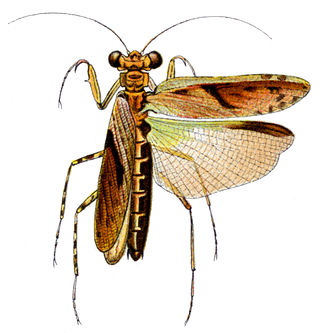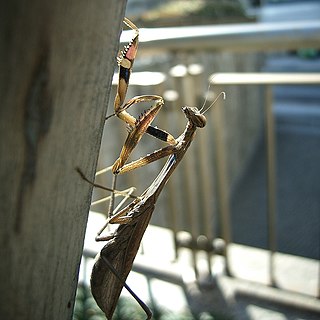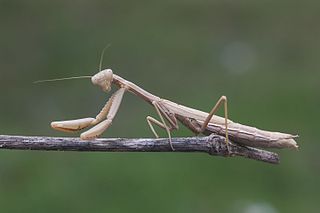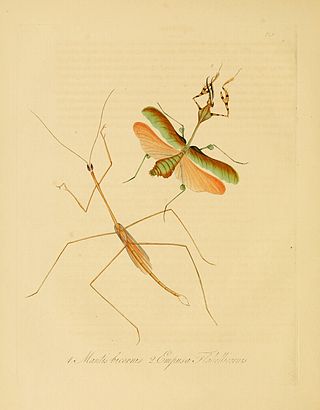
The Carolina mantis is a species of praying mantis of the subfamily Stagmomantinae.

Mantidae is one of the largest families in the order of praying mantises, based on the type species Mantis religiosa; however, most genera are tropical or subtropical. Historically, this was the only family in the order, and many references still use the term "mantid" to refer to any mantis. Technically, however, "mantid" refers only to members of the family Mantidae, and not the 14 remaining families of mantises. Some of the most recent classifications have promoted a number of the mantid subfamilies to the rank of family, e.g. Iridopterygidae, Sibyllidae, Tarachodidae, Thespidae, and Toxoderidae, while other classifications have reduced the number of subfamilies without elevating to higher rank.

Metallyticus is a genus of praying mantis. It is the only genus in the monotypic family Metallyticidae. They are mostly found in South-East Asia. The species of the genus are dark, somewhat flattened and cockroach-like, and often with a cuticle that is reflective and metallic in appearance.

Amorphoscelidae is a family of mantises in the order Mantodea.

Iris oratoria, known by the common name Mediterranean mantis, due to humans first studying it in lands around the Mediterranean Sea, is a species of praying mantis. Its range is expanding in the Middle East, Western Asia and the United States.

Statilia maculata, common name Asian jumping mantis or "小蟷螂", ko-kamakiri or "좀사마귀", joem-sa-ma-gui, is a species of mantis native to Asia that can be found in Romania, China and Japan and Korea and Sri Lanka.

Iris is a genus of praying mantis found in Africa, Asia, and Southern Europe with one species, Iris oratoria, being introduced to North America in the south-western United States.

Rhombodera is a genus of praying mantises native to Asia and possessing common names such as shield mantis, hood mantis, and leaf mantis because of their extended, leaf-like thoraxes.
Bolbena is a genus of praying mantises native to Africa. It includes the following species:

Antistia is a genus of mantises in the family Tarachodidae. There are at least four described species in Antistia.

Tarachodidae is a now obsolete family in the order Mantodea, of genera found in Africa and Asia.

Acanthopidae is a family of mantises consisting of 16 genera in the order Mantodea. The group was first formally split off as a separate family by the German entomologist Reinhard Ehrmann in 2002. In 2016, five genera were moved from Acanthopidae to the newly created family Acontistidae, but this has not been accepted in most recent classifications.

Mantises are an order (Mantodea) of insects that contains over 2,400 species in about 460 genera in 33 families. The largest family is the Mantidae ("mantids"). Mantises are distributed worldwide in temperate and tropical habitats. They have triangular heads with bulging eyes supported on flexible necks. Their elongated bodies may or may not have wings, but all Mantodea have forelegs that are greatly enlarged and adapted for catching and gripping prey; their upright posture, while remaining stationary with forearms folded, has led to the common name praying mantis.

Tenodera aridifolia is a species of mantis in the subfamily Mantinae. The Chinese mantis, T. sinensis, was once considered to be a subspecies of T. aridifolia, but the species can be distinguished by the shape of male genitalia.

Iris polystictica is a species of praying mantis found in Central Asia, Caucasus, southeastern Ukraine, southern Siberia, China, and Mongolia. It is the only species of the mantis genus Iris that is found in Russia.

Galinthiadidae is a family of 24 African mantis species in four genera.

Acontistini is a tribe of neotropical mantises in the superfamily Acanthopoidea, and family Acanthopidae. There are 7 genera and more than 30 described species in Acontistini. In 2016, several genera were moved from Acanthopidae to a newly created family Acontistidae, but this has not been accepted in most recent classifications.
Thespinae is a subfamily of mantises in the family Thespidae. There are 16 genera and at least 40 described species: found in Australasia, Central and South America.

Schizocephala is a genus of praying mantises in the monotypic tribe Schizocephalini. It is represented by a single species, Schizocephala bicornis. It is distributed across Pakistan, India, Nepal, Sri Lanka and the Sunda Islands.















